|
25 YEARS AGO ON AMBERGRIS CAYE BY ANGEL NUÑEZ

San Pedro Town, as you know it today, was once a very small village. To get an idea of how small it was, you would have to leave out Boca Del Rio Area, San Juan, Airstrip Area, San Pedrito, San Pablo, San Marcos, DFC area, and even Escalante Subdivision and Mosquito Coast area. When you leave all of that out, there you have the core of what used to be the little fishing village of San Pedro all the way up to the early 1960’s.
In subsequent issues of Ambergris Today, I will give you a brief history of each subdivision. Collect each issue to learn the history of the area in which you live. I will give it to you live and direct, so you will get it from the horse’s mouth.

| | The Blake House in the center of town.
|
In this first in the series, let us look at the town core. The town core today was what constituted the entire village in the 1950’s. The beginning of the town was more or less where the primary school is today. Nobody liked living beyond that area for it was a very dense “cocal” or coconut plantation. It was covered with high bush and infested with mosquitoes. In the 1950’s, that
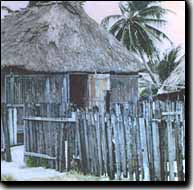
| | A typical thatch house of a local fisherman.
| primary school was not there. It was right in front of the police station, towards the beach. The end of the town was where the cemetery is today. Actually, back then the cemetery was considered to be right on the outskirts of the village. Don Ramon Badillo (deceased) lived on the property right before Milo’s Hotel and Ice place and nobody really liked living in that area as it was too close to the cemetery and too far. There was no Paradise hotel and beyond. Beyond the cemetery you found coconut trees along the beach all the way to the Boca Del Rio.
The Boca Del Rio Area
The area of Boca del Rio never existed twenty five years ago. From present day Paradise Hotel to Boca del Rio it was all bush. We called the waterway Boca del Rio, but it is not a river. It is a canal believed to have been cut by a hurricane or dug by the Maya Indians who inhabited the island many hundreds of years ago. If you wanted to enter that area, you had to get into the bush just past Paradise Hotel and adventure the wildlife. There were all kinds of birds that nested in the bush as well as two small marshlands or small lagoons in the area of the high school and Seven Seas Hotel.
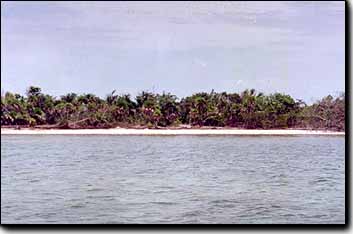
| | Boca del Rio area before development.
|
Children delighted in venturing into these areas to catch land turtles, which we kept as pets. The beach area was totally dirty with lots of seaweed and debris, which drifted from outer sea unto the beach. There were bottles, dolls, cans, bulbs, bamboo, buoys made of glass or plastic, sandals, shoes, and other odds and ends of things that were discarded from ships sailing through the Caribbean Sea. Children loved to practise target shooting by hurling stones at the bulbs and also wearing one sandal, which our parents told us was bad because of a superstition that your mother would die if you wear only one sandal. There is where I disproved superstitions for I wore lots of single sandals picked up along the beach. The seabed along this beach was infested with conch. If you paddled your dory along the beach you could load it with conch in an hour or so. The conch was collected mostly for home use, to make a scrumptious conch ceviche, or a delicious conch chowder.
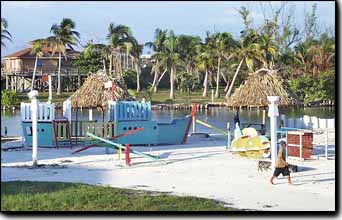
| | Boca Del Rio area even has its own park now.
|
There were some really smelly areas along the beach from Paradise to the Boca del Rio because there were patches of mangroves where the debris settled and a horrible stench was created. These dirty smelly areas discouraged anyone from living on those areas.
Now the entire area from Paradise Hotel to the river belonged to one Mr. Roger Reid, who was married to one of the Blake daughters, so I imagined he got that for free or very little money. When the village really needed land for expansion back in 1971, this was the area that the government of Mr. George Price decided to acquire to provide land for the villagers. The court settled on an acquisition price, which I recall was about 72 thousand dollars, and the local lands committee proceeded to issue land to those interested. Ironically, the entire area was to have been a residential area, but with no zone planning at the time and no forceful Housing and Planning Authority, the first developments after a few homes were some hotels too. People got their plots of land for something like four thousand dollars. Some villagers later on turned and sold their parcels for 75 thousand dollars, more than the price for the entire Boca Del Rio Area.
One of the first to build in the area was George Eiley and Mrs. Leonor Rosado. It was a challenge for there were no roads, lights, telephone etc. The high school broke grounds back in 1981, and up until then there were no amenities in the area. Yes, past students recall entering the jungle out there with shovels and machetes to clear the bush to start building the new school, and like them, many others who cleared their land to make the entire Boca Del Rio Area what it is today. All of this occurred more or less from 1980 to the present. The lovely houses along the beach of Boca Del Rio are a testimony of a hard working people who helped carve a part of our Isla Bonita. Twenty Five Years Ago salutes you.
Area No. 3 - San Juan
We have seen the first two areas of our town that were developed, the first one being the town core and the second one the Boca Del Rio Area. The next area in chronological order is the San Juan Area. This area comprises the entire area behind Boca Del Rio Area, or the area that is by the lagoon. Boca Del Rio goes from past Paradise to the river on the seaside, and San Juan is the entire stretch from behind Belize Electricity Limited all the way to the river on the lagoon side.
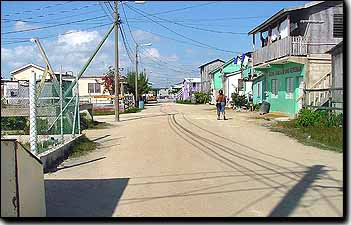
| | San Juan Area and the San Juan Statue at entrance of the general area.
| This area has an interesting history. Actually the land was mangrove and was acquired in 1971 the same time that the Boca Del Rio was acquired. It was acquired by the government of George Price, but Boca Del Rio was developed first because it was good land. The Lands Committee had the intention to fill the lots by means of dredge before giving it out. However, in 1984 something strange happened. Even though there was a PUP town board in San
Pedro, there was a UDP government in Belmopan. It was just the opposite of politics today. Now in 1984 the UDP appointed a lands committee in San Pedro and that committee opted to issue the land as it was- without a survey, without a proper subdivision, without infrastructure of sewerage, water and electricity, and even without the proper applications for lease or purchase. The committee simply wanted to give out the land to gain political popularity and advantage.
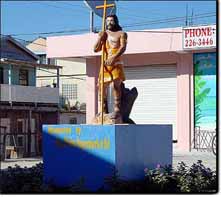 As a result of the above, the area was developed very haphazardly, with small dilapidated shacks, no streets, no septic tanks, no water system, and electrical poles planted everywhere and people borrowing electricity from one another. The place really looked like a mess and smelled like a mess. There were streets filled up with house garbage, and yards that were underwater whenever it rained. There were reports of people running sewer pipes to the lagoon, and on one occasion a person built a small shack right on the street because there were no survey markers. While the committee kept issuing lots, some simple squatted on the land and claimed squatter’s rights. There were some people that simply got their lots, sort of filled it up with seaweed and sold the lots for real estate. San Juan grew as the people wanted or as they could afford, not according to the town board plans. I can tell you of this because I was in the town board and was against this development in that manner, but there was nothing I could do. I could have killed the lands committee chairman, whose name I choose not to mention publicly.
As a result of the above, the area was developed very haphazardly, with small dilapidated shacks, no streets, no septic tanks, no water system, and electrical poles planted everywhere and people borrowing electricity from one another. The place really looked like a mess and smelled like a mess. There were streets filled up with house garbage, and yards that were underwater whenever it rained. There were reports of people running sewer pipes to the lagoon, and on one occasion a person built a small shack right on the street because there were no survey markers. While the committee kept issuing lots, some simple squatted on the land and claimed squatter’s rights. There were some people that simply got their lots, sort of filled it up with seaweed and sold the lots for real estate. San Juan grew as the people wanted or as they could afford, not according to the town board plans. I can tell you of this because I was in the town board and was against this development in that manner, but there was nothing I could do. I could have killed the lands committee chairman, whose name I choose not to mention publicly.
As a result of this mess, consequent mayors like Pete Salazar, Baldemar Graniel, and even Don Beto Nuñez, had to spend a lot of time, resources, and efforts to improve the area. The town was a tourist town and we could not afford such a ghetto in San Pedro. Today, with the efforts of past town councils and the people of San Juan, much improvement has been accomplished. You can drive in the San Juan area and appreciate a better standard of living. Yes, there are areas still in dire need of development, but if you see it today and did not know how it looked in the late 1980’s you would think I am telling you a lie. The people living in San Juan did not like admitting that they lived there. It was perceived that the people living in town core and Boca Del Rio were better than San Juan. There was discrimination and this inferiority complex. It was compared to the Yarborough (Yahbra) area of Belize City where only poor people lived and there was widespread sale of drugs.
However, both the PUP and the UDP needed votes and campaigned hard in that area and as a result made some promises and had to keep some of their promises. And so it was that San Juan received attention and improvements. There are fine streets now, with some really nice homes and businesses. Even the beachside street by the lagoon looks good and there are plans for a lagoon seawall like the one in town core. San Juan will soon be another proud area of our Isla Bonita with supermarkets, schools, a park, and even brick streets. San Juan is coming up and is another proud testimony of the resilience and optimism of our people in San Pedro. Thumbs up to San Juan.
Area No. 4 - San Pablo
The lovely residential area of San Pablo was the fourth area in San Pedro to be developed after the town core, Boca Del Rio, and San Juan. This area was conceived in the minds of Hon. Area Representative, Glenn Godfrey along with the PUP Town Board at the time. It was conceived with the idea of providing much needed land for residential purposes and to offer it at very low prices considering that real estate had driven prices up to the sky.

| | Aerial view of San Pablo 2002.
|
The ninety or so acres was purchased from a foreign group known as Caribbean Coves, and it managed by a company known as Sunset Coves because it is illegal for the town board to handle real estate. To obtain the money to purchase the 100 percent mangrove area, Sanpedranos put the money up front and with five hundred dollars you could own one lot, two lots for seven hundred dollars and three lots for one thousand dollars. Then dredges were moved in to start filling the lots. Lots along the canals were sold at ten thousand dollars to foreigners mostly and the money was used to finance the cost of filling the residential lots.
Again dirty politics entered the scene and something happened at Sunset Coves. A piece of land in town was traded with a piece of land in San Pablo to build the Ambergris Stadium. It was a lovely project, but the paperwork was not completed and the UDP government entered Belmopan. Because of hatred for Glenn Godfrey, there was a threat to sue Sunset Coves for thousands of dollars because the government would not honor the sale of lots in town by the high school. This would have meant the losing of the stadium and San Pablo as well. Therefore Godfrey and partner, Mr. Gillett, who was the land developer, opted to put Sunset Coves into a receivership, or else the government would have taken it over. As such Gillett became the receivership and so the land passed on to other parties.
Unfortunately not everyone received their two or three lots. Everyone got only one. The remainder of the land was eventually turned over to a new company known as Western Caribbean and was sold to D.F.C. (The Development Finance Corporation) for a housing project, the same area now known as D.F.C area.
San Pablo has grown from two or three houses first owned by Lincoln Eiley, Bruce Collins of the San Pedro Sun, and yours truly, who was the third person to move in the San Pablo area. Today most of the lots now boast lovely homes and construction is on going. The canal lots and beachside lots offer attractive residential properties. Lots can be purchased from DFC for about thirty thousand dollars each and private owners have put up the sale of one lot for up to sixty thousand dollars. San Pablo now offers to its residents peace and tranquility, electricity, phone, cable television, and water. Sewer service is not yet offered, but it is something worthy to be considered by BWS. And yes, it boasts the only public sports stadium in town. With the commercial marina passing through that area, soon it will be another busy section of town. Congratulations to all residents in the subdivision who have developed it into a nice residential area, an area that all can be proud of.
Area No. 5 - San Pedrito
The fifth area in San Pedro to be developed into a residential development was San Pedrito. It was so called because it was like an immediate extension of San Pedro proper. With the huge success of San Pablo, Glenn Godfrey knew that more land for the residents of San Pedro would please many people and also win him another election as he was looking for his second term of office. So he and his committee focused their eyes in a swampland area behind the airstrip and towards the lagoon.
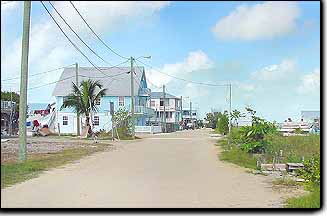
| | San Pedrito neighborhood.
|
The land had belonged to Taff Elliott and group and Glenn easily convinced them to sell over the few acres to the government for development. In 1992 the area was divided and people were invited to apply and come out for a public drawing in which lots were assigned to them even before subdivision of the area. In fact, the then Area Representative Godfrey had also obtained monies from the Baron Bliss Trust Fund to start a civic center for San Pedro, which was to be named the Dame Minita Civic Center. There was a symbolic ground breaking ceremony for that project at the same time lots were issued to all the residents who had applied. Filling of the mangrove area was to follow shortly.
In 1993, the following year, general elections were held and even though Godfrey won his seat, the UDP won the general elections and Godfrey became sort of powerless in terms of representation with government. The Governor General of Belize, Dame Minita Gordon, was replaced and with that the civic center dream dissolved. A UDP lands committee was appointed and they called the shots in the San Pedrito area. Something very similar to San Juan occurred. The bottom line was that the parcels were given out without any land filling and without any infrastructure. The result was a residential development that gave much to be desired. People attempted to fill lots with garbage and the streets were below sea level. If the problem was bad when there were mosquitoes, it was worse when it rained and the entire area was underwater. For many years there were massive efforts to improve the area with politicians and town leaders lending it much attention and the residents battling themselves.
Today, after a final blow by Hurricane Keith, San Pedrito has undergone much improvement, with better streets, homes and businesses. It is no longer the forgotten area of San Pedro. It has come a long way and residents of San Pedrito can all be proud of their accomplishment of a place they call home. Twenty Five Years Ago and Ambergris Today salute you.
Area No. 6 -
Escalante Subdivision
This is certainly not twenty five years ago, and is one of the few subdivisions that is not named after a Saint. Is there a San Escalante that we can name it after? This area is a full residential area with only a few small businesses operating there.
It must have been about 1995 or 1996 during the first UDP town council administration when Manuel Heredia was Mayor that this area was conceived. The town council negotiated with Mr. Escalante who owned several acres just north of Victoria House. Once permission to use the land for lots was obtained, this project was not advertised for the townspeople to apply for their lots. It was secretly arranged so that those who had close ties with the town council got one. Lots were in high demand and they went like hot cakes. Immediately the area was cleared, subdivided and some infrastructure was installed, including electricity and water.
At the beginning, the building of homes went slowly even though most of the land was good and ready to build on. Only a few areas in Escalante needed refill. Soon a few homes were built and the area looked pretty good so that it incited others to build. There are some real fine houses in the area and residents should feel very proud of a fine job done in the area.
Today Escalante has several apartments and one condominium. There is a school and a church is being built there also by the Seventh Day Adventist Mission. The streets are well kept and the neighborhood is generally clean. Perhaps there is need of a park for the area and a playing ground and sports field would not be a bad idea. Past Mayor Alberto Nuñez has personally told me that there are about six lots that have been reserved for general purposes like the building of a volley/basketball court that would greatly enhance the area. Other open spaces might be used for town council purposes that would serve the general interests of the neighborhood. Good job by the town council in conceiving the subdivision plan and by the residents who have properly developed the area into a place they can be proud of and can call home. Hopefully the present town council will add and improve the area with these sporting facilities. I guess Twenty Five years ago should salute the master planners, the residents who had faith and the Escalantes, who cooperated with the council to make the sixth residential area for San Pedro a success.
The Remaining Subdivisions
The once small fishing village of San Pedro, Ambergris Caye is now an extended town with some ten subdivisions. Yes, ten subdivisions. We once thought of Belize City as the large city with its colorful subdivisions like Freetown, Albert, Mesopotamia, Fort George, Pickstock, Landivar, Yarborough, Port Loyola, and Bella Vista. Who would have thought that San Pedro would have grown to incorporate Boca Del Rio, San Juan, San Pablo, San Pedrito, Escalante, San Marcos, Mosquito Coast, Colonia San Diego, DFC, and in the near future Ambergris Bay?
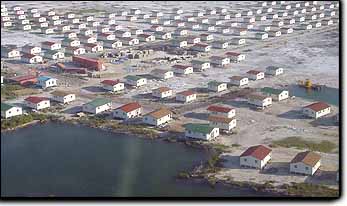
| | DFC Housing Area beyond San Pablo Subdivision.
|
The first six subdivisions are now history. The remaining ones are in the making. San Marcos grew to a lovely residential area in the past five years only. This area was subdivided by a private landowner and sold to interested persons. The past town councils have helped in infrastructure including building of streets. Then there is Mosquito Coast with lovely residences where some of the finest residents of San Pedro live. That area was subdivided by Bob Witte of Holiday Lands and made it available to interested parties. Again local government has helped with infrastructure and amenities like cable television have been provided by the private sector. Colonia San Diego is on the other side of the river or the Boca Del Rio and though it is pretty rough living, it is coming along. DFC, named after the Development Finance Corporation that provided the funding for low-income housing grew almost overnight. Godfrey who had control of some of the Caribbean Coves land, made the land available to DFC and about two hundred homes were erected almost overnight. Most of the homes now belong to residents, who once rented; now they are proud owners of their own homes and properties. Most of the infrastructure is in place and mostly landfill is needed to make living a bit more comfortable during the rainy season, but again private owners have to be commended for the tremendous progress they have realized with their own efforts. DFC is looking brighter and beautiful day by day.
So what are the new areas to be developed into subdivisions after the other ten are filled to capacity. There is some room in San Pablo and Mosquito Coast and even San Marcos for growth, but where else to go? San Pedro town core is filled. Only if someone decides to sell can you ever think of building anything new in the downtown. Where else to build? The answer is probable the new area dreamt and created by Patty Arceo, and that is Ambergris Bay. It will take one or two brave people to build there and create the need for infrastructure. After that, I can see people building their retirement homes, and a whole new village will be created. That village will be the eleventh subdivision for San Pedro and will probably take us into the year 2040. By then Twenty Five Years Ago will be Fifty or Sixty Years Ago, and if the writer is still around, we will be celebrating the accomplishments of our beloved San Pedro. By then Ambergris Today will probably be a periodical, a magazine, or a daily newspaper with 50, 000 daily hits in the Internet. Ladies and gentlemen, hats off to salute San Pedro, the little village founded by the Mestizos in 1848 and now the hottest town in the country of Belize. Aren’t you proud you can call it “home”? Twenty Five Years Ago also salutes you for being a part of San Pedro and Ambergris Caye.
|